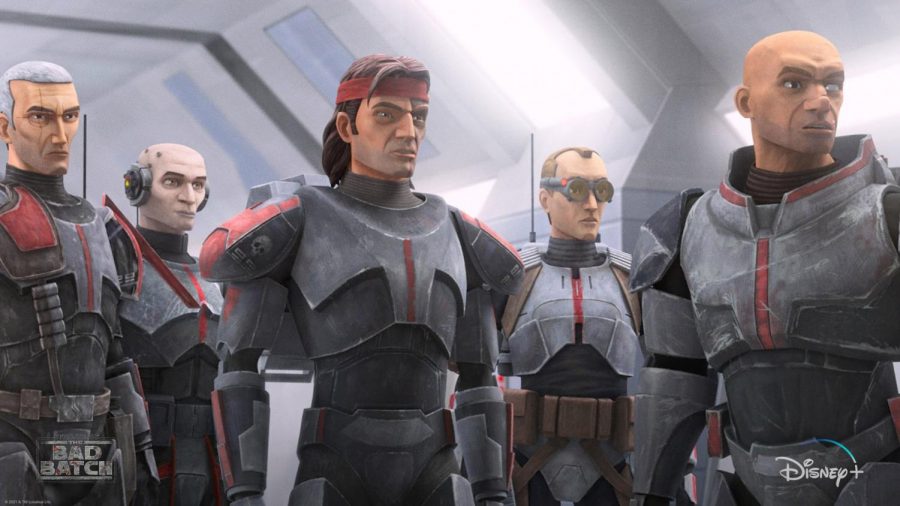Star Wars: The Bad Batch Season 1 Review – Both Fascinating and Frustrating
September 27, 2021
Star Wars: The Bad Batch is Lucasfilm’s 4th animated series, following Star Wars: The Clone Wars, Star Wars: Rebels, and Star Wars: Resistance. For context, this show takes place between Episode III: Revenge of the Sith and Episode IV: A New Hope, while acting as a spiritual successor to Clone Wars. The Galactic Republic has an army of clone soldiers that have worked for years with the Jedi, sorcerer-esc peacekeepers, to defend the galaxy from those who oppose its order. However, the Republic has fallen, with the clone soldiers turning on the Jedi to serve new masters, leading to the formation of the new Galactic Empire. The show follows five defective clones – Hunter, Echo, Tech, Crosshair, and Wrecker – who each have their special abilities which, when put together, enable them to overcome the most improbable of odds. With this regime change, as well as Omega, a mysterious female, child clone, joining up with them, the Bad Batch must now adapt to survive the coming change in the galaxy, while evading the empire.
Firstly, it is recommended that you have watched at least some of Clone Wars. Hunter, Wrecker, Tech, and Crosshair were all first introduced in the seventh season of the show, with Echo appearing back in season one. The familiarity of the galaxy at the time of the Galactic Republic that the show provides will also be useful, as you might be lost without the context.
With that being said, The Bad Batch’s 16 episodes are filled with both high highs and low lows, very comparable to other Star Wars animated outings.
To start with some positive aspects of the film, the animation throughout the entire season has been the best that the team at Lucasfilm has delivered to this date. The show is a visual feast to those who are fans of animation, with each texture being lit and sculpted in the most pleasing way possible. The character models are varied and distinct, from both the background characters to the Batch themselves, with every movement and action made being free of clipping or funky animation. Perhaps the biggest benefit of this is the visceral environments found on the different planets, with each one feeling unique and vibrant. This helps them escape archetypes that are far too common, such as “generic junk planet” or “generic forest area.” The standouts have to be Daro, visited in the 13th episode, War Mantle, which one could mistake for a real-life environment, and Kamino, which turns out to be more appealing to visit than it was in the live-action films.
The sound design and score in the first season are also fantastic, but that is common with every Star Wars series. David W. Collins is the lead sound designer, allowing the galaxy that has long been far, far away to never sound more alive. Every planet has a distinct vibe due in part to the sound design, while weapons have the sense of similarity to both those of the past era and the emerging one. This feeling of eras combining is fully connected through the score present in the show. The soundtrack will constantly shift between the score of the Age of Republic present during the prequel trilogy and the motifs present in the John Williams’ score present in the original trilogy of films. This perfectly captures the plot thread of the shifting regimes present in the Galaxy, making the viewers believe that the change is occurring.
In terms of the actual story of the show, it is certainly very appealing. One of the main themes of the show is how the Batch needs to adapt to survive the coming galactic changes, which is a theme present throughout the entire show. Hunter and the rest of the Batch must adapt to Omega being present, as looking after a child is something that they never had to do before. Seeing the Batch becoming mercenaries is also an interesting concept, as they now must do various missions that challenge several of their morals, altering the status quo that they have sworn to protect during the old war. Seeing how quickly the empire is taking over the galaxy is terrifying, often leaving chills down your spine at how the roles have reversed: the clone soldiers that previously served the people are now being controlled against their will to control and undermine them.
However, the pacing of the show strongly undercuts the engaging narrative. Each of the episodes that follow the Batch’s encounters with the empire that advance the plot is separated by mercenary missions, which range from good to bad, depending on the episode. This reveals a heavily criticized element throughout many Star Wars animated shows, “filler” episodes! For example, Rescue on Ryloth, the 12th episode of the season, is a very climactic episode, with the ending promising a more fast-paced couple of episodes, with the empire hot on the tails of the Batch. However, it is followed up by episode 13, Infested, which has almost nothing to do with the danger that the Batch now has to face. Episode 14, War Mantle, is then another episode that follows the Batch’s tussle with the empire. This often leads to the pacing of the show is jarring in a way that keeps the viewer unengaged, which is frustrating, as War Mantle and Rescue on Ryloth are two of the best episodes of the season.
Another aspect of the show that many are conflicted about is the characters. The Batch themselves often come off as one-note and kind of useless to the narrative, with not many of them developing much. Hunter gets nice moments with Omega, as well as interesting moments where he is tested as a leader, but never fails to escape the standard “good guy” archetype. Omega is a nice inclusion, acting as both a moral compass for the Batch and another full-member, capable of taking care of herself. Wrecker gets a nice subplot across the first seven episodes, but does not get much afterward, Tech likewise. However, the biggest offense is Echo, who gets next to nothing to do in the season. This will upset a lot of people, as he was one of the main characters of Clone Wars, with his only notable moment being in War Mantle. Contrastingly, though, Crosshair is probably the only character that gets a fully realized arc, with every episode he is furthering his development. Without getting too much into spoilers, Crosshair is very much afraid to adapt, causing him to develop into a very conflicted and ambiguous character, though I would have liked his development to occur in more episodes. Overall, a mixed bag.
In terms of the voice acting, though, there is not much more a fan could ask for. Dee Bradly Baker is the voice for all of the clones, giving every member of the Batch a distinct, yet familiar, voice that perfectly captures their personalities. Hunter is a little smoky and keen, Tech’s is easy-breezy, Wrecker’s is excitable, Echo’s is grumpy, and Crosshair has the voice of a coiled snake, ready to strike at any moment. Michelle Ang lends her vocal talents to Omega, providing the kid with an earnest voice that fits the character. Across the 16 episodes of the first season, there are also a variety of cameo appearances from characters across the past Star Wars series and films. Some have been in the trailers, such as Ming Na Wen’s Fennec Shand from The Mandalorian, Andrew Kishino’s Saw Gerrera from past seasons of Clone Wars, and a few other surprising appearances. The cameos sometimes became a bit too attention-grabbing, making the universe feel small, but most of the spots were fairly fun to witness.
Overall, the first season of Star Wars: The Bad Batch is probably the strongest start for a Star Wars animated show, though that is not saying much. Both Rebels and Clone Wars started roughly, with both series not peaking until later on in their lifespan, addressing the complaints of those prior. Hopefully, The Bad Batch will see a similar transformation during its second season, though in its current state the show remains a cluttered collage of episodes that range from really good and engaging to those that are dull and forgettable. There are more well-received episodes than there are criticized ones though, as episodes such as Aftermath, Replacements, Battle Scars, Reunion, Rescue on Ryloth, War Mantle, and Return to Kamino outshine episodes like Decommissioned, Devil’s Deal, and Infestation. As it stands, Star Wars: The Bad Batch is a fascinating, yet frustrating, look at how the Republic fell and the empire rose, all through the perspective of the soldiers that are caught up in the middle of it. With this in mind, the show receives a score of 6/10, decent yet lacking in certain key areas.

